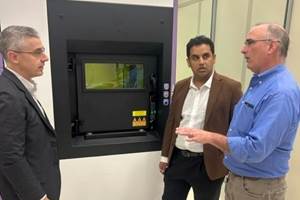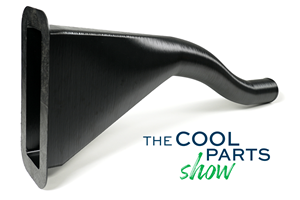Large-Volume VFGF 3D Printer Produces Modular Helicopter Cockpit Simulator
The Queen 1 VFGF system from Q.BIG 3D produced a complete modular helicopter cockpit simulator in just over a month, all while offering high surface quality, fast build rates and lightweight construction.
The 3D manufactured cockpit frame assembly made of a partially aromatic polyamide with 25% glass fiber content (Q.mid GF25). Source: Q.BIG 3D
Q.BIG 3D’s Queen 1 variable fused granulate fabrication (VFGF) system was able to achieve a new level in 3D extrusion additive manufacturing (AM) with the production of a complete modular helicopter cockpit simulator assembly in just over a month, all while offering fast build speeds, high surface quality and dimensional accuracy with constant gap dimensions.
Reiser Simulation and Training, in Berg, Germany, commissioned Murtfeldt Additive Solutions (Murtfeldt AS) in Kusterdingen, Germany, to produce a modular cockpit for a full-flight helicopter simulator. The cockpit was successfully manufactured at Murtfeldt on a Queen 1 system via a VFGF process for large-volume 3D extrusion printing.
The project aim was to overcome the limitations of conventional manufacturing strategies, such as classic mold-based processes (especially for large-volume components), which can incur high tooling costs and long lead times. According to the companies, that might mean a project like this could take 3-6 months to complete.
In addition, conventional fused deposition modeling (FDM) printers usually cannot produce large-volume 3D components, often have uneconomical build rates and also use material containing filaments which can be seven times more expensive per kilogram compared to a plastic granulate 3D printer.
In contrast, the 3D extrusion production process eliminates tooling costs while enabling new build strategies for novel component geometries combined with shorter amortization periods. When compared to alternative AM strategies (such as FDM printers), this technology can use commercially available standard granulate without filaments, thereby saving material costs.
The 3D cockpit was made by additively manufacturing all assembly components with final cockpit dimensions of 2,260 × 1,780 × 1,705 mm. The cockpit weighs only 200 kg as the 3D printing enabled a resource-saving lightweight build. Murtfeldt AS used a partially aromatic polyamide with 25% glass fiber content (Q.mid GF25) for the cockpit frame. With 0% lengthwise and 0.2% crosswise fibers, it is said this material has particularly high dimensional stability, high temperature stability up to 200°C, high stiffness and excellent paintability.
Although the manufacture of all components took just over a month, Murtfeldt AS expects shorter build times for a follow-up project by optimizing the process chain. A printer network comprising several Queen 1 machines can also shorten the delivery time for time-critical requests. The longest single build job was almost 100 hours.
Michael Ortmann, from Reiser Simulation and Training, was responsible for the design and development, and says the advantages of 3D extrusion printing offered a number of potential benefits that previously did not seem possible. “Extremely short time-to-market, high build speed, lightweight construction, bionics, functional integration and cost-effective manufacturing without the need for molds along with the merits of using granulates, to name just a few aspects,” Ortmann says.
In addition, the process provided control of distortion in the large and complex components, tight tolerances of gap dimensions and high surface quality. Dimensional accuracy was also of fundamental importance for screw fastenings and precise pinning.
Reassembling the demountable module at the user’s location was also advantageous, along with the fact that two helicopter models (Airbus Helicopters H135 and H145) could be cost-effectively simulated using a conversion kit. Also, functional integration (such as integrated cable races) are possible because of the segmentation of the 3D assembly. Overall, there are significant price advantages for the finished assembly for suppliers and end users while, at the same time, the cockpit is available at very short notice.
Certain features of the Queen 1 3D extrusion printer offered advantages for this production process:
- High surface quality, even in the case of the geometry’s strong overhangs.
- A high degree of accuracy of fit of the components in the assembly (dimensional accuracy, small gaps) due to the active temperature control of an outer chamber as well as the build space, which made a stable and repeatable process possible.
- Temperatures of not only the build space but also the entire mechanical system are kept constant, regardless of temperature fluctuations in the production hall itself.
- The variable nozzle is a key feature. The fast build rates are due to a variable nozzle control system, which adapts to the particular characteristics of each geometry. Delicate areas of the components are built up in the normal nozzle mode. Large infill areas on the thick pillars of the cockpit, however, are created in a fast turbo mode in order to reduce the build duration while at the same time increasing stability. Modes change automatically.
- In terms of design, Reiser specified sensitive areas for the nozzle control. For example, solid material was specified at the mounting points of the door hinges. This enabled greatly reduced build times compared to continuous nozzle use, as well as material-saving lightweight construction of the 3D components.
The team also noted that using the Queen 1 system technology with no tooling costs enables users to have a low investment risk and eliminate postprocessing costs. This strategy also offers advantages over competing AM strategies, such as SLS or FDM printing, which mean that components often have to be glued together. This can result in disadvantages in terms of functionality, tightness of fit and dimensional accuracy due to imprecise tolerances.
“With the innovative VFGF system technology from Q.BIG 3D for large-volume 3D components, we at Murtfeldt can specifically tap into further areas of application for the VFGF manufacturing strategy,” says Johannes Matheis, Murtfeldt AS managing director. “If you master the entire process chain, complex, large 3D components with high repeatability and component quality on a new level are possible.”
Related Content
3D Printed Lattice for Mars Sample Return Crash Landing: The Cool Parts Show Bonus
NASA Jet Propulsion Laboratory employs laser powder bed fusion additive manufacturing plus chemical etching to create strong, lightweight lattice structures optimized to protect rock samples from Mars during their violent arrival on earth.
Read MoreNew Zeda Additive Manufacturing Factory in Ohio Will Serve Medical, Military and Aerospace Production
Site providing laser powder bed fusion as well as machining and other postprocessing will open in late 2023, and will employ over 100. Chief technology officer Greg Morris sees economic and personnel advantages of serving different markets from a single AM facility.
Read MoreAt General Atomics, Do Unmanned Aerial Systems Reveal the Future of Aircraft Manufacturing?
The maker of the Predator and SkyGuardian remote aircraft can implement additive manufacturing more rapidly and widely than the makers of other types of planes. The role of 3D printing in current and future UAS components hints at how far AM can go to save cost and time in aircraft production and design.
Read MoreAircraft Ducts 3D Printed in Composite Instead of Metal: The Cool Parts Show #68
Eaton’s new reinforced PEKK, tailored to aircraft applications, provides a cheaper and faster way to make ducts compared to formed aluminum.
Read MoreRead Next
Crushable Lattices: The Lightweight Structures That Will Protect an Interplanetary Payload
NASA uses laser powder bed fusion plus chemical etching to create the lattice forms engineered to keep Mars rocks safe during a crash landing on Earth.
Read More3D Printed Polymer EOAT Increases Safety of Cobots
Contract manufacturer Anubis 3D applies polymer 3D printing processes to manufacture cobot tooling that is lightweight, smooth and safer for human interaction.
Read MoreBike Manufacturer Uses Additive Manufacturing to Create Lighter, More Complex, Customized Parts
Titanium bike frame manufacturer Hanglun Technology mixes precision casting with 3D printing to create bikes that offer increased speed and reduced turbulence during long-distance rides, offering a smoother, faster and more efficient cycling experience.
Read More





















